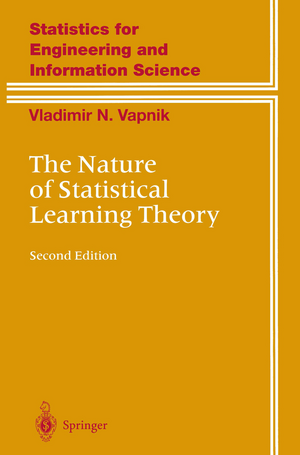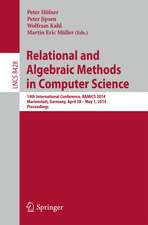The Nature of Statistical Learning Theory: Information Science and Statistics
Autor Vladimir Vapniken Limba Engleză Hardback – 19 noi 1999
| Toate formatele și edițiile | Preț | Express |
|---|---|---|
| Paperback (1) | 1322.20 lei 6-8 săpt. | |
| Springer – dec 2010 | 1322.20 lei 6-8 săpt. | |
| Hardback (1) | 1151.30 lei 17-23 zile | +97.21 lei 7-13 zile |
| Springer – 19 noi 1999 | 1151.30 lei 17-23 zile | +97.21 lei 7-13 zile |
Din seria Information Science and Statistics
- 24%
 Preț: 1327.60 lei
Preț: 1327.60 lei - 20%
 Preț: 415.71 lei
Preț: 415.71 lei - 18%
 Preț: 1384.56 lei
Preț: 1384.56 lei - 18%
 Preț: 1114.83 lei
Preț: 1114.83 lei - 18%
 Preț: 1125.09 lei
Preț: 1125.09 lei - 15%
 Preț: 647.73 lei
Preț: 647.73 lei - 20%
 Preț: 1059.92 lei
Preț: 1059.92 lei - 20%
 Preț: 1050.02 lei
Preț: 1050.02 lei - 18%
 Preț: 956.03 lei
Preț: 956.03 lei - 20%
 Preț: 650.27 lei
Preț: 650.27 lei - 18%
 Preț: 897.65 lei
Preț: 897.65 lei - 15%
 Preț: 583.56 lei
Preț: 583.56 lei - 15%
 Preț: 591.79 lei
Preț: 591.79 lei -
 Preț: 386.61 lei
Preț: 386.61 lei - 20%
 Preț: 1284.14 lei
Preț: 1284.14 lei -
 Preț: 394.51 lei
Preț: 394.51 lei - 20%
 Preț: 989.31 lei
Preț: 989.31 lei - 18%
 Preț: 953.03 lei
Preț: 953.03 lei - 20%
 Preț: 335.52 lei
Preț: 335.52 lei - 18%
 Preț: 891.02 lei
Preț: 891.02 lei
Preț: 1151.30 lei
Preț vechi: 1514.88 lei
-24% Nou
Puncte Express: 1727
Preț estimativ în valută:
220.30€ • 230.63$ • 182.28£
220.30€ • 230.63$ • 182.28£
Carte disponibilă
Livrare economică 11-17 martie
Livrare express 01-07 martie pentru 107.20 lei
Preluare comenzi: 021 569.72.76
Specificații
ISBN-13: 9780387987804
ISBN-10: 0387987800
Pagini: 314
Ilustrații: XX, 314 p.
Dimensiuni: 155 x 235 x 28 mm
Greutate: 0.65 kg
Ediția:2nd ed. 2000
Editura: Springer
Colecția Springer
Seria Information Science and Statistics
Locul publicării:New York, NY, United States
ISBN-10: 0387987800
Pagini: 314
Ilustrații: XX, 314 p.
Dimensiuni: 155 x 235 x 28 mm
Greutate: 0.65 kg
Ediția:2nd ed. 2000
Editura: Springer
Colecția Springer
Seria Information Science and Statistics
Locul publicării:New York, NY, United States
Public țintă
ResearchCuprins
Introduction: Four Periods in the Research of the Learning Problem.- 1 Setting of the Learning Problem.- 2 Consistency of Learning Processes.- 3 Bounds on the Rate of Convergence of Learning Processes.- 4 Controlling the Generalization Ability of Learning Processes.- 5 Methods of Pattern Recognition.- 6 Methods of Function Estimation.- 7 Direct Methods in Statistical Learning Theory.- 8 The Vicinal Risk Minimization Principle and the SVMs.- 9 Conclusion: What Is Important in Learning Theory?.- References.- Remarks on References.- References.
Recenzii
From the reviews of the second edition:
ZENTRALBLATT MATH
"...written in a concise style. It must be recommended to scientists of statistics, mathematics, physics, and computer science."
SHORT BOOK REVIEWS
"This interesting book helps a reader to understand the interconnections between various streams in the empirical modeling realm and may be recommended to any reader who feels lost in modern terminology, such as artificial intelligence, neural networks, machine learning etcetera."
"The book by Vapnik focuses on how to estimate a function of parameters from empirical data … . The book is concisely written and is intended to be useful to statisticians, computer scientists, mathematicians, and physicists. … This book is very well written at a very high level of abstract thinking and comprehension. The references are up-to-date." (Ramalingam Shanmugam, Journal of Statistical Computation and Simulation, Vol. 75 (2), February, 2005)
"The aim of the book is to introduce a wide range of readers to the fundamental ideas of statistical learning theory. … Each chapter is supplemented by ‘Reasoning and Comments’ which describe the relations between classical research in mathematical statistics and research in learning theory. … The book is well suited to promote the ideas of statistical learning theory and can be warmly recommended to all who are interested in computer learning problems." (S. Vogel, Metrika, June, 2002)
ZENTRALBLATT MATH
"...written in a concise style. It must be recommended to scientists of statistics, mathematics, physics, and computer science."
SHORT BOOK REVIEWS
"This interesting book helps a reader to understand the interconnections between various streams in the empirical modeling realm and may be recommended to any reader who feels lost in modern terminology, such as artificial intelligence, neural networks, machine learning etcetera."
"The book by Vapnik focuses on how to estimate a function of parameters from empirical data … . The book is concisely written and is intended to be useful to statisticians, computer scientists, mathematicians, and physicists. … This book is very well written at a very high level of abstract thinking and comprehension. The references are up-to-date." (Ramalingam Shanmugam, Journal of Statistical Computation and Simulation, Vol. 75 (2), February, 2005)
"The aim of the book is to introduce a wide range of readers to the fundamental ideas of statistical learning theory. … Each chapter is supplemented by ‘Reasoning and Comments’ which describe the relations between classical research in mathematical statistics and research in learning theory. … The book is well suited to promote the ideas of statistical learning theory and can be warmly recommended to all who are interested in computer learning problems." (S. Vogel, Metrika, June, 2002)
Caracteristici
The aim of this book is to discuss the fundamental ideas which lie behind the statistical theory of learning and generalization. It considers learning as a general problem of function estimation based on empirical data. Omitting proofs and technical details, the author concentrates on discussing the main results of learning theory and their connections to fundamental problems in statistics.


























